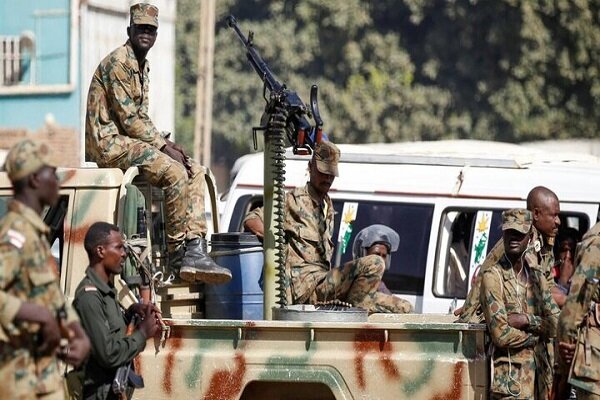The Destructive Role of the U.S. and Israel in Sudan Is Clear; Deadly Silence of the International Community

Mehr news Agency, International Desk: For over two years, ideological conflict has devastated Sudan and continues to intensify between the Sudanese Armed Forces (SAF) and the paramilitary Rapid Support Forces (RSF). What began in April 2023 as a power struggle among military factions has escalated into a full-scale civil war. This conflict has displaced millions and caused more than 150,000 deaths. The United Nations describes Sudan’s crisis as the world’s largest humanitarian disaster. Yet while global attention focuses on Palestine,the people of Sudan remain abandoned in silence-residents of El Fasher now bear the harsh consequences of international neglect.
The Tehran Times spoke with Mohammad Saad Kamel, a Sudanese journalist and editor-in-chief of Brown Land News Agency. The following is an excerpt from that interview.
As a journalist who has closely followed events in Darfur, how would you describe what is happening there now? Is this a continuation of the tragedy sence 2003 or have these conflicts taken on a new form?
The situation in Darfur amounts to genocide-the first phase enacted by paramilitary groups known as Janjaweed. These are Arab tribes originally from Central and West Africa who united with aims to establish control over Darfur by eliminating its Black population.Unfortunately, these tribes receive support from countries such as Chad that implement policies aligned with the United Arab Emirates.
The conflict’s objectives have evolved.During Omar al-Bashir’s era, Janjaweed militias were formed to suppress rebellions-the government maintained partial control over them despite grave abuses. Today’s reality is starkly different; foreign backing now supports RSF forces just as rebel groups once received outside aid against al-Bashir’s government. It is evident this external interference targets Sudan’s unity and stability directly. The Janjaweed commit horrific crimes including widespread sexual violence against women; they kill children and elders-and proudly document their atrocities on camera.
What do you see as the root causes of this renewed violence in Darfur? Are these conflicts purely ethnic and tribal or driven by deeper political and economic factors?
The reasons for recurring violence align with interests of states sponsoring instability-such as the U.S., which previously backed rebels under humanitarian intervention pretexts while arming insurgents claiming human rights protection was its goal.
Currently those same weapons flow through UAE channels-with Israel’s tacit approval-to armed groups like Janjaweed who were once enemies to those rebels. Ethnic tensions have been exploited merely as tools for implementing this broader scheme. Previously “marginalization” of African communities was cited to justify fueling conflicts but today it is indeed clear these narratives mask larger premeditated agendas.
How much duty do you attribute to SAF and RSF forces for these atrocities?
the world knows well that RSF rebelled against Sudan’s government committing crimes nationwide: rapes targeting women; killings involving children and elders-all recorded proudly by Janjaweed militias themselves.
By contrast,Sudanese army forces historically defend national sovereignty against incursions by gangs or mercenaries.
Regions controlled by SAF generally enjoy relative security whereas civilians flee areas held by RSF militias seeking refuge under army protection.
Therefore all accountability lies firmly with Rapid Support paramilitaries.
Africa at large suffers grievously due to global indifference-a tragic narrative fully reflected by darfur’s plight.
Many consider Darfur a proxy battlefield for regional & global powers vying for influence.Do you believe UAE,Egypt,and U.S.have intensified this conflict?
There’s no doubt whatsoever,Business rivalries among regional & international actors play out sharply across Darfur.
The Russia-U.S.rivalry extends here: America backs RSF via allies suchas UAE & Chad while Russia supports Sudanese state forces.
Competition revolves heavily around port control,the source escalating tensions.Behind slogans promoting “maritime security” &”regional stability,”Abu Dhabi operates covert intelligence linking Tel Aviv & Washington,
a network remapping naval trade routes stretching from Bab-el-Mandeb Strait through Suez Canal.These dynamics expand confrontations toward Red Sea turning them into colonial contests over power projection.
how do you assess global reaction-including UN response-to killings in Darfur? Why dose current international acknowledgment far fall short compared with 2003?
In 2003,the world supported insurgents opposing than-government.Today,the same global players endorse new rebellions fueled via paramilitaries like Janjaweed-this time mainly through their silence about atrocious crimes committed throughout Sudan.It remains evident Western powers ledby U.S.and Israel back any move sowing chaos within Sudanesesociety .
You’re partof media covering armed group crimes.What dangers do journalists face reporting here?Have threats or censorship affectedyou or colleagues?
during ongoing hostilities more than forty journalists lost their lives,many others kidnappedby Rapid Support troops;the latest case concerns an Al Jazeera correspondent abducted inthe cityof El Fasher.All sources ofincomehave vanishedasall newspapers shut down,manymedia shifting solelytowardonline platforms inadequate tosustain livelihoodsforthisgrowingjournalist population .


